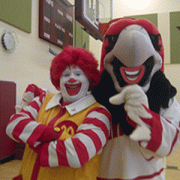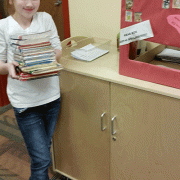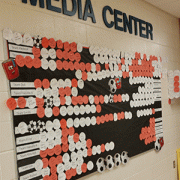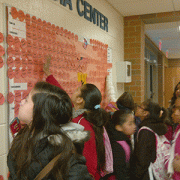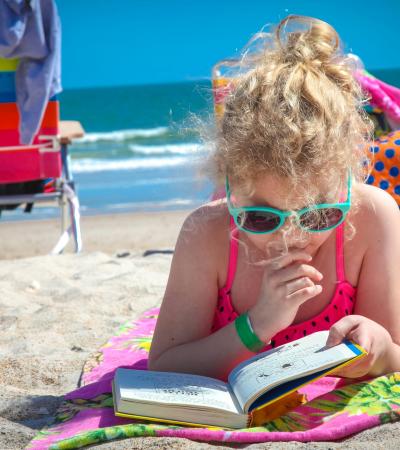March Madness is a reading competition between teams within our school. The program was created to promote reading in a school where kids weren't reading enough. I found that the students could read, but only when they were excited about it.
Most students don't know what to read or are overwhelmed at what to select. The March Madness competition provides a platform to excite students about reading and offers them selections of books from which to choose. Our school's media center is important to this competition as it takes pressure off teachers to introduce book characters and activities to the students; instead, our media specialists coordinate book introductions. The teams, comprising different classes, compete against each other to earn points for their team through the Accelerated Reading program. Students are able to track their team's progress by checking a scoreboard near the library.
Advanced Planning
Planning begins in January, a few months prior to the event, so teams can be established, prizes bought and the Pep Assembly scheduled. At a breakfast meeting, staff, teachers and administrators are introduced to the competition. Teams are made up of different classrooms; typically we have between 25 and 28 teams.
Marketing
Teachers, library/media personnel and administration meet two times to establish guidelines for the March Madness competition. Students are introduced to the competition by a Pep Assembly and kept up-to-date of their standing throughout the competition
Budgeting
We usually spend about $500 on incentive prizes for the top reading group. The profits from our book fair have paid for the rest of the event. This year, the PTO also paid for a top winner of each grade level to receive a tablet. In past years, I have only given one tablet to an overall winner from the primary grades and one tablet to an overall winner for the intermediate grades.
Day-of-event Activity
There are multiple activities throughout the month of March that encourage student reading during March Madness.
The month of reading events kick off with a Pep Assembly on the last Friday in February. A typical Pep Assembly begins with the drumline or band playing in the hallway as the students enter the gymnasium. When students enter, they encounter the basketball team warming up and mascots (like Ronald McDonald or Swoop the Redhawk) mingling with the students. Inside the gym, loud music, like "Jock Jam," blares from the speakers. At the assembly, the students listen to a guest speaker, the principal and me. I, with the help of a few assistants, usually show off the prizes and explain the rules to the students. I try to hype up the students by asking them, "What is your favorite book?" and "Who is going to win?" and saying things like, "Let's hear a cheer from the third graders that want to read!"
During the competition, classes compete against each other to score the most points. Kids read between classes, they ask to read at art and gym, they are on the playground reading and the media center is packed both before and after school. Students take the books home to read, too. Many teachers incorporate reading chapter books during their scheduled language arts time that month. All classes also have a scheduled free-reading time each week in the library; the kindergarten classes visit twice a week. With all the opportunities to read, the points add up quick! And students are always up-to-date because team scores are announced every morning over the loud speaker. Many kids also check the March Madness bracket outside the media center to keep up-to-date with class scores.
At the end of the competition, prizes are awarded. The classroom with the most overall points is treated to a Book Fair Breakfast. On the first day of the fair, students are awarded doughnuts, juice and milk as they enter the fair before any other students in the school. At the fair, they are allowed to pick out one item apiece. (This item can be a pack of books, so long as it is packaged as a single item.) Most students pick out a "Guinness Book of World Records," though other students choose a single book or trilogy pack. Each class also has an Most Valuable Player (MVP), the student who scored the most points by the end of the competition. This year, the MVPs were each given a donated basketball. The PTO also gifted the highest scoring student of each grade with a tablet.
Program Execution
We use the Reanaissance Learning Accelerated Reader program to track student points. The students compete at their own STAR reading levels. For example, "Harry Potter and the Deahly Hallows" has a book level of 6.9, which means that a sixth grader could likely read the text well during their nine month of instruction. "Harry Potter 7" has 34 AR points, which means a student can earn 34 points by earning 100 percent of the associated quiz. Receiving less than 100 percent earns a child a proportional amount of points. For example scoring 60 percent on the "Harry Potter" quiz would earn a student 20.4 points. Look up the points for Accelerated Reading books.
To help encourage students, the teachers have access to the AR points and can help monitor the student's reading and points. Many teachers put up their own charts in their classrooms and give their students reading goals. The competition also involves the students beyond just reading. This last year, we had 54 student volunteers work in the media center to help check out a total of 80,000 books over the course of the school year.
Our kindergarten students use a slightly different system. We give these students advice-sight words, sometimes known as Dolch words. Teachers send their students home with flash cards of common words that their parents can help them learn. Kindergartners that learn all their sight words receive a prize, such as a mini-basketball, books and/or candy.
The first year the students read 6,000 books. The second year the students read 10,000, and in the third 12,000. This year, the fourth year, our students read 14,000 books. The program was so popular that a Bounce Back to Books program was created for the fall.
Advice
We are always considering how to improve the program for future years.
We have found that book funding is always a problem. Most of the time, we don't have enough copies of the popular titles for each kid that wants one to have at the same time. I have implemented a "Read Box," where students can write down a request and drop it in the box if there is a title they want to read that we don't have.
I was also thinking of implementing a genre wheel of some sort, so the class teams have to read one book from every genre in the library at their reading level.


